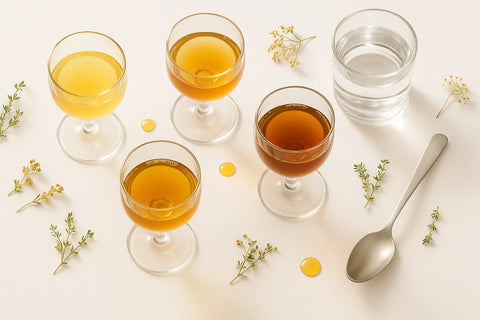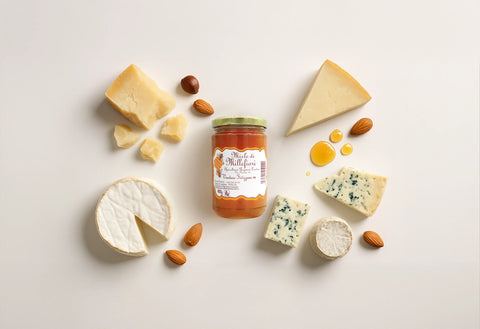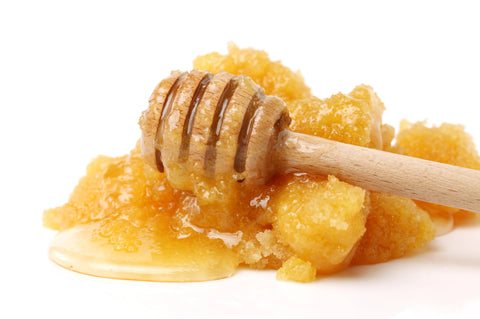Honey tasting is a sensory experience that allows you to fully appreciate the unique characteristics of this precious natural food. In this guide, you'll discover how to properly taste honey and recognize its quality, aromas, and flavor nuances like a true expert.
Preparing the Perfect Environment for Tasting
The environment in which we taste honey significantly influences our sensory experience. To achieve optimal results, it's essential to create ideal conditions:
-
Temperature: maintain the environment between 18° and 22°C (64° and 72°F) to preserve the organoleptic characteristics of honey
-
Lighting: prefer natural light or neutral lighting that allows you to appreciate authentic colors
-
Humidity: moderate humidity (40-60%) helps to better perceive aromas
-
Absence of odors: choose an environment free from perfumes or intense odors that could interfere with smell
Essential Tools for Professional Honey Tasting
For optimal tasting, you need few but essential tools:
-
Transparent stemmed glass containers (similar to wine glasses)
-
Stainless steel or inert material spoons
-
Room temperature water to cleanse the palate
-
A notebook to record your impressions
The 5-Step Tasting Process
1. Visual Examination: The Secrets of Color and Consistency
The first approach to honey occurs through sight. Take about 30 grams of honey and place it in the glass, gently spreading it on the walls to increase the surface area in contact with air.
Observe carefully:
-
The color range (from pearly white to light yellow, from amber to dark amber)
-
Clarity or opacity
-
The presence of crystallization (natural in many quality honeys)
-
The homogeneity of the structure
-
Any characteristic reflections or fluorescence
Honey color is an important indicator of its botanical origin: lighter honeys tend to have more delicate flavors, while darker ones generally present more intense and persistent notes.
2. Olfactory Analysis: Perceiving the Aromas
After distributing the honey on the glass walls, bring your nose to the opening and take short, quick inhalations. Repeat the operation after 20-30 seconds, when the aromas will have fully developed.
During this phase, try to identify:
-
Aromatic intensity (from very delicate to very intense)
-
Predominant olfactory families (floral, fruity, vegetal, warm, chemical)
-
Specific notes (citrus, vanilla, caramel, aromatic herbs)
The aromas of honey tell the story of the flowers from which it comes and the territory that generated it.
3. Tasting: Discovering the Authentic Flavor
Take a teaspoon of honey and let it slowly dissolve in your mouth, mixing it with saliva. Distribute it over the entire surface of your tongue to activate the different taste areas.
Focus on:
-
Fundamental flavors (sweet, acidic, bitter, salty)
-
Taste balance
-
Flavor persistence
-
Retro-olfactory aromas that are released during tasting
Remember that each honey has its own balance of sweetness, acidity, and bitterness that makes it unique.
4. Tactile Sensations: Consistency and Texture
Honey consistency is a fundamental element in qualitative evaluation. During tasting, pay attention to:
-
Fluidity or density
-
Crystallization (fineness of crystals, homogeneity)
-
Palate adhesiveness
-
Solubility in mouth
-
Any particular tactile sensations
Crystallization is not a defect but a natural process that varies based on honey composition and influences its texture.
5. Final Evaluation: Overall Harmony
At the end of tasting, evaluate the overall harmony of the honey, considering:
-
Aromatic persistence
-
Balance between different sensations
-
Taste cleanliness (absence of defects)
-
Typicality compared to the declared variety
Some Advice for Optimal Tasting
To fully appreciate the qualities of honey, avoid:
-
Tasting after consuming meals or foods with strong flavors
-
Using oral hygiene products immediately before tasting
-
Wearing perfumes, aftershaves, or intensely scented cosmetics
-
Smoking, drinking coffee, alcohol, or aromatic beverages before tasting
Ideally, schedule your tasting in the morning, when taste buds are most receptive.
Comparative Tasting: A Discovery Experience
To refine your tasting skills, try comparing different types of honey in the same session. Start with more delicate honeys and proceed towards more intense ones, interspersing tastings with sips of water to cleanse the palate.
This practice will allow you to appreciate the subtle differences between varieties and recognize the distinctive characteristics of each honey.
Consciously tasting honey means embarking on a sensory journey through territories, seasons, and blooms. With practice, you'll learn to recognize the nuances that make each honey a unique and unrepeatable product, an authentic expression of our territory's biodiversity.
Discover our selection of artisanal honeys and begin your tasting journey with products of excellence, carefully selected to offer you only the best from nature.



